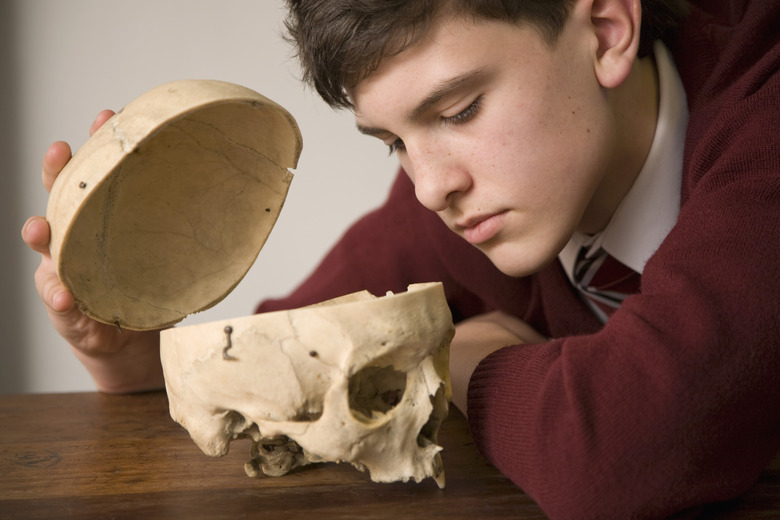Easy Ways To Remember The Structures Of The Skull
Memorizing the structures and parts of the skull might seem daunting with names like "occipital" and "mandibular." While these might initially seem overwhelming, they don't need to be. Learning some basic English language words will help enormously because suddenly a student will realize that most skull anatomy and skull structures are appropriately named.
In fact, most of the names of the skull's structures aptly describe their location and function, which ends up being an easy way to remember bones of the skull.
The Parts of the Skull Are Aptly Named
The Parts of the Skull Are Aptly Named
There are various bones that together form the human skull. It is not a single bone. While this might seem overwhelming — there are numerous bones to memorize — all of the bones of the human skull are named to identify their location. The frontal bone, for example, is obviously located in front of the head. Other bones are more complicated, but still logically named. The temporal bone abuts the head's temples, and the sphenoid bone, which is named partly related to the word "sphere," is located behind the eye. The eye, of course, is sphere shaped.
Mouth Pieces
Mouth Pieces
The pieces of the mouth are also aptly named if a student can understand the reasoning behind their names. The lower part of the mouth, for example, is called the mandible. This is because the word manducate means to chew, and thus the root of the word — mand — has something to do with chewing.
Likewise, the maxilla is above the mandible, and forms the upper half of the mouth. Memorize this by knowing that the "max," which is short for maximum, is greater than the mandible and thus above it.
Nasal Bones and Structures
Nasal Bones and Structures
Words like the "nasal spine" are also straightforward and easy to memorize. Luckily, the nasal spine, which is a structure below the nose, looks like a mini-spine leading up to the nose.
The nasal concha, meanwhile, is the hole in the skull where the nose rests. This can be easily memorized because the term "concha" refers to the famous seashell that makes beautiful noise: the conch shell. Because the bone is shaped like this shell, it can be memorized easily.
Other Parts of Skull Anatomy
Other Parts of Skull Anatomy
Other significant parts of the skull include the sutures, especially the coronal sutures. These sutures surround the top of the head, like a crown. "Coronation," the term that denotes the inauguration of a royal monarch, is closely related to the word "coronal," which links to the royal aspect of the coronal suture. Thinking about royalty will solidify the coronal suture in your mind.
The lamboid suture, meanwhile, is in the rear of the head, and this can be memorized because lambs (in LAMBoid) are typically followers of a shepherd, and are thus in the back.
Mnemonic Devices
Mnemonic Devices
Mnemonic devices are techniques and/or phrases that you come up with to help you remember certain things. They're also called memory devices. While it's often most helpful to come up with ones on your own, here are some examples of well-known skull anatomy mnemonic devices:
All of the cranial bones: Old People From Texas Eat Sandwiches (Occipital, Parietal, Frontal, Temporal, Ethmoid, Sphenoid)
Facial bones: Virgil Can Not Make My Pet Zebra Laugh (Vomer, Conchae, Nasal, Maxilla, Mandible, Palatine, Zygomatic, Lacrimal)
Scalp nerve supply: GLASS (Greater occipital/Greater auricular, Lesser occipital, Auriculotemporal, Supratrochlear, Supraorbital)
These are just a few examples. Create your own for each area of skull anatomy to have an easy way to remember bones of the skull and other skull structures.
Cite This Article
MLA
Wandrei, Kevin. "Easy Ways To Remember The Structures Of The Skull" sciencing.com, https://www.sciencing.com/easy-ways-to-remember-the-structures-of-the-skull-12759122/. 4 June 2019.
APA
Wandrei, Kevin. (2019, June 4). Easy Ways To Remember The Structures Of The Skull. sciencing.com. Retrieved from https://www.sciencing.com/easy-ways-to-remember-the-structures-of-the-skull-12759122/
Chicago
Wandrei, Kevin. Easy Ways To Remember The Structures Of The Skull last modified March 24, 2022. https://www.sciencing.com/easy-ways-to-remember-the-structures-of-the-skull-12759122/
